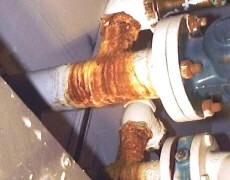PIPE CORROSION
The corrosion of steel piping and
its related components is a continuous and virtually unstoppable process. Pipe
corrosion exists as one of the most potentially damaging threats to industrial
property second only to fire.
A very first step toward resolving
any corrosion problem is to establish the overall condition of the piping system
through a general ultrasonic investigation. Clearly identified problem areas can
be further defined through the use of metallurgical analysis.
By comparing metallurgical against
ultrasonic test results, it is possible to identify the extend and severity of
the corrosion condition within the piping system. We will document not only the
corrosion mechanism itself but also the remaining integrity of the system is
critically important in order to minimize the potential damage from leaks.
With a properly performed piping
evaluation, comprised of 100 or more individual ultrasonic tests per piping
system, a clear and reliable determination of the piping can be produced.
From an initial set of wall
thickness measurement and review of the plant history it is possible to derive
valuable information regarding the present state of each location tested.
Information such as;
- - Pipe metal loss.

- - Corrosion rate.
- - Remaining pipe
service.
- - Estimate
retirement date.
- - Pass or fail
recommendations.
- - Overall piping
conditions.
Given sufficient wall thickness
testing it is possible to create the comparison of;
- - Original pipe
thickness v/s measured values.
- - Corrosion rate.
- - Corrosion rate
vs. pipe size.
- - Corrosion rate
vs. material used.
- - Corrosion rate
vs. physical location.
- - Corrosion rate
vs. direction.
For each and every test location a
set of corrosion rate and retirement date calculation based upon the average of
all 6-wall thickness values is provided. Under normal conditions such estimates
provide a reliable indication of pipe conditions.
Calculations of wall loss and
corrosion rate are based upon the assumption that all measured loss has taken
place evenly over its time in service.
Predictions of allowable loss,
remaining pipe life and retirement date show an estimate of the piping, from its
current wall thickness, will reach minimum recommended wall thickness standards
Such predictions have proven
tremendously valuable, recommending replacement at near
failure condition, as well as saving the cost of unnecessary replacement.
|



